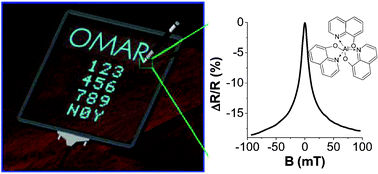Magnetoresistance in π-conjugated organic sandwich devices with varying hyperfine and spin–orbit coupling strengths, and varying dopant concentrations†
Abstract
We study a recently discovered organic magnetoresistive (OMAR) effect whose underlying mechanism is currently not known with certainty. We examine the hypothesis that OMAR is caused by spin-dynamics by varying the strength of the hyperfine and spin–orbit coupling in the organic semiconductor material. We show that unlike most other materials, C60 devices do not exhibit the OMAR effect. Therefore hydrogen atoms and the resulting strong nuclear hyperfine coupling is a necessary prerequisite for the observation of OMAR. We investigate the dependence of OMAR on the strength of the spin-coupling introduced by heavy atoms in two widely used organic semiconductors, and find the characteristic magnetic field scale shifts to much larger fields. We also study OMAR sandwich devices made from the conducting

- This article is part of the themed collection: Emerging Investigators

 Please wait while we load your content...
Please wait while we load your content...